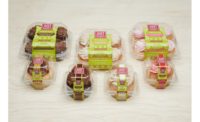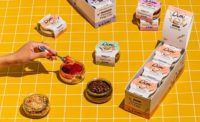Not Just Desserts
By Jeanette Hurt
Low-fat and sugar-free desserts are no match for today’s indulgent-seeking consumers. Rather, smaller portions and fruit-filled creations are perfect alternatives for topping off an enjoyable meal.
When it comes to desserts, people talk a lot about cutting down on calories and making healthier choices. But when actually picking out a dessert in the grocery store or ordering from a menu, it’s a different story.
“Everybody’s asking for healthy, low-fat or sugar-free, but if you actually have them in a tasting or on a buffet, they’re just being left there,” says Thomas Huebner, MPC, executive pastry chef for the Arizona Biltmore Resort & Spa in Phoenix. “Anytime I have low-fat items, they just don’t sell. If they’re going out to have a nice meal with a ton of calories, they don’t care about the extra calories of the dessert. Low-fat desserts are more of a joke than a reality, as in ‘Yes, all our desserts are fat-free, and they have no calories.’”
Carol Christison, executive director for the International Dairy-Deli-Bakery Association, points out that numerous studies show consumers believe they can improve their health with a better diet and that those folks are called “wellness consumers.”
“But, and it’s a big but, as in B-U-T-T, there’s only a small core of wellness consumers who actually practice what they preach,” Christison says. “When it comes to the majority, they spend as much time talking about fat as they do chewing it. They don’t change their eating habits.”
The International Food Information Council reports that 88% of consumers can’t accurately estimate the number of calories they should eat, half of them can’t even guess the amount, and more than one third of Americans are clinically obese, but only one in 10 of them recognizes that. So for restaurant and dessert companies, this is good news. People still want to indulge — and they want to indulge in big and small ways.
“It’s like ordering a Big Mac, a large fries and a Diet Coke,” says Jim Stang, marketing communications manager with Wow Factor Desserts, in Alberta, Calif. “When it comes to dessert, if you’re ordering a dessert, it is an indulgence, so people don’t say ‘I want the caramel pecan flan light, please.’”
But when they do indulge, they want their indulgence to count.
“If someone offers them a turtle cheesecake or a New York cheesecake or a sundae, they’re going to say ‘I can get that anywhere,’” says Mark Strothmann, Sr., vice president of Suzy’s Cream Cheesecakes and Distinctive Desserts in Milwaukee. “But you’re going to have a hard time passing up a Root Beer Float/White Chocolate Cheesecake. The tendency is for people to ask themselves the question ‘When am I going to see that again?’ If people are going to indulge, to make the accommodations to have a dessert, they want it to be worth the calories.”
That’s why companies like Suzy’s are making it worth the extra calories — from using cage-free eggs and two kinds of cream cheese to get that right flavor to coming up with new flavors like Root Beer Float Cheesecake, as well as Dark Chocolate Stout cheesecake.
Comfy Foods
However, consumers also are looking for comfort, says Nancy Finkelstein, co-owner with her brother Howie Lefkowitz of Carousel Cakes, Nanuet, N.Y. Carousel Cakes’ Red Velvet Cake recently was featured in Oprah Winfrey’s O magazine.
“The Red Velvet Cake is an old-fashioned cake, but it’s very new on the East Coast,” Finkelstein says. “It’s become the new chocolate. It used to be just a seasonal cake, but now, it’s an all-year-round cake.”
Upscale restaurant products have been important to consumers, and desserts are no exception to the rule.
“Our super-premium desserts are growing at a faster rate than our mainstream desserts,” says Chuck Hemmingway, marketing director for Sara Lee Sweet Goods, Sara Lee Food & Beverage, Downers Grove, Ill.
As Strothmann says, “Luxury isn’t just something a wealthy person will buy. People will buy more expensive items based on emotional attachment. It used to be that you wanted to be in the middle of the market, but what we are seeing now is a marginalization on the high and low ends of the market.”
What also is growing — for Sara Lee and many other companies — is smaller portions.
“Small is the new big when it comes to portion size,” Christison says. “It doesn’t mean that they’re eating less. It just means that they’re eating a lot of smaller items.”
Sara Lee recently introduced Simple Sweets, 6-in. pre-baked fruit pies in apple and cherry flavors. This fall, the company will add new fruit pies to the line.
“It’s hard to control yourself, so really, a whole pie is great when you’re having friends or family over, but when it’s a snacking occasion, Simple Sweets is just the right size for one or two people,” Hemmingway says. “This trend is tied in to the ability to control the portion size, but it’s also tied to the trend of the growth in one or two person households.”
Strothmann says that Suzy’s has downscaled its portion sizes, especially in grocery stores, but restaurants still are asking for larger portions. Carousel Cakes has seen great growth in cupcakes, so much so that it has opened a new Cupcake Café in Westwood, N.J.
“Cupcakes are very popular,” Finkelstein says. “They’re inexpensive, easy to carry, and people can get six cupcakes, split them in half and have a variety.”
Never ‘Nuff Chocolate
Chocolate remains popular in indulgences, and right now, the more bitter the chocolate, the better. In the last four years, dark chocolate sales have increased almost 50%, totaling $1.8 billion.
“Some restaurants now have chocolate sommeliers, and they are offering dessert courses that include cheese, chocolate and port wines,” Christison says.
But lighter tasting desserts, as well as individually portioned desserts, also are growing.
“Chocolate’s always big, but we’re noticing a lot of demand for fruit flavors,” Stang says. “Things that taste lighter on the palette. It’s something you can eat at the end of a meal to satisfy your sweet tooth craving, but not so that you walk away from the meal feeling bloated.”
Strothmann also has noticed growing demand for more fruit cheesecakes.
“We don’t cut the calories in the dessert, but we cut the fat by adding more fruit,” he says. “People want to indulge, but they also want to indulge in things that are healthy for you, like wild Maine blueberries with organic streusel on the top. It’s a way of cutting the fat without compromising the flavor.”
That touches on another key trend, Christison says.
“Consumers are interested in cutting calories, but they are not willing to give up taste,” she notes. “To avoid a negative connotation, don’t call your foods ‘indulgent.’ Instead, call them ‘enjoyment foods.’ Trigger words that entice people include micro, house-made, gourmet, guilt-free, convenient, ethical, wild, line-caught, hand-fed, boutique, flights, pairings and sampler.”
Regardless of the selection, desserts are luxuries people will never tire of in the long run.
“They are something that never goes out of style, especially cakes,” Finkelstein says. “It’s something most people will have — even if it’s just one bite.” SF&WB
Think Pink
People want desserts that not only taste good, but make them feel good … perhaps even by doing good.
That’s why Carousel Cakes, Nanuet, N.Y., came up with a pink version of its popular Red Velvet Cake. The Pink Velvet Cake is an organically colored cake whose proceeds benefit the National Breast Cancer Research Organization.
Carousel Cakes also makes a Pink Ribbon Cheesecake that benefits the same organization. Both desserts are made with the company’s signature hand-finished frosting.
“They’re really yummy, and we’re very excited about them, especially since October is Breast Cancer Research month,” says Nancy Finkelstein, co-owner of the company her father founded in 1975.


